Чем дальше в будущее входим,
тем больше прошлым дорожим
И в прошлом красоту находим
Хоть новому принадлежим
В. Шефнер
We live in the 21st century, today often called «The Century of Child». A lot of European countries today have taken this position. I am proud to mention the fact that my in country Russia too the year 2018 has been declared «the Decade of Happy Childhood» and in Bashkortostan 2018 year is the Year of Family and family relations and values.
Man is born. He has come to live. He deserves to be happy, No other material values can be measured with a broad happy smile of a child! What does it mean? I often wonder at this question. What makes us children, since the birth, laugh, not cry and fell assured in the family? Perhaps Mum and Dad, their love and warmth and what is more – a lot of toys! – I think.
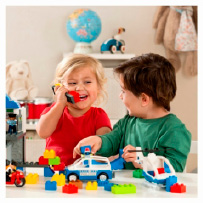
Since early days of my childhood I have still remembered my first toys and among them, of course, dolls! A few, but they were my favorites! And even today I`ve got the warmest recollections of those old toys, dear to my childish heart!
Of course, today the world has changed greatly: dolls that can sing and dance cars that move at the touch of a button and airplanes that fly, robotic toys that can entertain every kid.
Having studied a lot of special literature, the works of great classics, fairy tales proverbs and sayings, Internet resources and surveying results, I have taken the history of a doll’s origin in Russia and Britain and its influence upon the fate of people through studying the works of Masters of Art and Pen as the Subject of my Research.
I have decided to study this problem in two cultures: Russia and Britain as well.
According to Longman Dictionary of Contemporary English there are more than 65 words and expressions concerning the concept «rag doll»:
Rag doll – Br.E., Am E; noun (countable) a soft doll made of cloth.
In Muller Dictionary there are only 7items of the word» doll»:
Doll [dↄ:ll] 1) кукла; Paris doll – манекен; 2) куколка, хорошенькая, пустоголовая девушка или женщина.
In S.I. Ozhegov Dictionary of the Russian Language the word «doll» means: «Детская игрушка с человеческой фигурой.
V. Dal Dictionary of the Russian language shows the concept as: женская кукла, кукляшечка, жен. кукленок, – ночек муж., сделанное из тряпья, битой бумаги, дерева и др. Подобие человека, а иногда и животного. Детская кукла, живая кукла, автомат.
According to Indian Sanskrit the word «doll» in these cultures can be traced off in the following formats:
1. Slavic – Koukla (from Greek), lala, Alla, lalaka,
2. Turkish – bebek
3. Germanic – puppe, puppet, doll
4. Latin – cuccula
5. French – pouppee
Methods of the Research are: studying dictionaries, context and Internet resources, searching, and systematization of information, generalization, and interviewing, audiovisual methods.
Theoretical value of my Project is to show that we, the children of our common planet, the Earth, mustn’t forget the history of our childhood, national traditions and customs, our ancestors and their magic world.
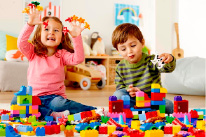
The knowledge of our own national authentic culture will enrich us, and help to understand other people’s past better and fuller: children all over the world would play, are playing and will play different games, especially with their traditional puppets, folk rag dolls, I am sure.
Main Body
Фея знала свое дело, и летая в небесах.
Днем и ночью, то и дело совершала чудеса,
Фея кукол создавала, мастерила, колдовала,
Все, чего она касалась, оживало, просыпалось
И в ее руках послушно обретали куклы души,
Ведь у кукол судьбы тоже с человеческими схожи
А потом свои трофеи раздавала людям всем
Потому что это средство, чтобы вечно помнить детство.
Лариса Рубальская
While researching our theme, I have used a lot of encyclopedic sources in my work: according to a lot of scientists, archeologists a doll is a model with a human figure. It accompanied a person from birth to death and was an emblem of a lot of holidays in the history of mankind.
Today we have known about 90 types of dolls. A folk rag doll was not just a toy, it carried a specific function: the ancient Slavs thought that such a doll would protect children’s sleep and would save a child from evil forces. Dolls were often made without a face, they served as amulets.
According to ancient belief, there can’t live impure spirit in a doll without a face.
In my research I have noticed a striking thing: the toys did not look equal even within the same street. Each family made them their own way: dolls would carry the imprint of spiritual environment of families and their understanding of the world. Toys were often made of old rags, clay, wood, bone, straw, parti-colored threads.
Dolls were handmade-no scissors or cutting instruments were used! They were created by mothers, fathers, grandmothers and grandfathers with great love, tenderness and wisdom. Children felt it and would treat their dolls with carefulness and concern.
Most dolls in Russia were amulets:
Doll-ward – protected a child from illnesses and troubles, a real angel, in fact, It was!
Doll-poleshko – a talisman of family happiness.
Wedding lovebirds cherished a young family from evil eye.
Doll-rush would chase away all the ailments and impure forces.
Since ancient times the dolls have been considered strong magic tools, able to bring good luck, protect from evil forces and fulfill desires.
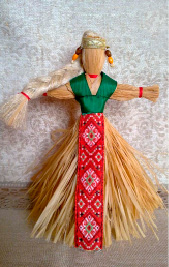
The Slavic ward doll
Куколка народная – чудо из чудес! Нет тебя пригожее и милее нет. Мама дочке делала, всё тепло вложив… Лоскуток к лоскутику примотав, не шив. Чтоб уколов не было от судьбы лихой,. Чтоб счастливой доченька выросла большой, Чтоб была подруженькой кукла ей всегда И беду и радости с ней всегда деля. Пусть живут традиции на Руси моей! Пусть играют в куколки доченьки детей!
Народная кукла Лупанчук О.Ю.
The secrets of ancient magic puppets have always been a typical theme of discussion for a lot of progressive Russian people since ancient times.
A lot of Masters of Pen devoted their works to the magic world of dolls and their role in a human fate: soothing helpers, wise body – guards for wretched orphans in Russian fairytales. Dolls often shared children’s sufferings and their hardships and troubles: F. Dostoevsky is «The Boy At the Christmas – Tree Party» is about an orphan boy on Christmas Eve: «There are fir- trees in warm bright windows, a lot of happy laughter is felt everywhere: and only he, the only one is received nowhere- no home, no compassion to such children, no toys…»
V. Korolenko is one of my favorite Russian writers of the XIX century and his book «The Underground Children» shows us the horrible helpless state of children, thrown out into the outskirts of life. Starved, without home and comfort, with numerous illnesses, they were usually doomed to death:
The image of Marusya, talently depicted by the author, made my heart shudder with deep compassion: «Это было бледное, крошечное создание, напоминавшее цветок, выросший без лучей солнца. Но в свои четыре года, она ходила плохо, неуверенно ступая кривыми ножками и шатаясь, как былинка; руки её были тонки и прозрачны, головка покачивалась на тонкой шее, как головка полевого колокольчика, глаза порой смотрели так не по-детски грустно…»
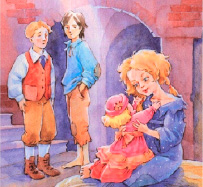
«The Underground Children» V. Korolenko
The author underlines a great role of a doll in his work, a big doll with bright painted face and luxuriant flaxen hair for little Marusya: «Действие этой нарядной фаянсовой барышни на нашу больную превзошло все мои ожидания. Маруся, которая увядала, как цветок осенью казалась, вдруг опять ожила. Она так крепко меня обняла, так звонко смеялась, разговаривала со своей новой знакомой…
Маленькая кукла сделала почти чудо! Маруся, давно уже не сходившая с постели, стала ходить, водя за собой свою белокурую дочку, и по временам даже бегала, по-прежнему шлепая по полу слабыми ногами».
We can see here, that the doll was a real magic for ill girl, a medicine – it was the first and last joy in her short life… (p.32 V. Korolenko «The Underground Children») (Издательство «Детская литература») 1971.
But in E.T. Nosov`s story «The Doll» the author shows сruel and outrageous attitude of people to «The toy with a human soul – doll:».
«Езжу я и в район, и в область и вижу « то тут, то там – под забором ли, в мусорной куче – выброшенные куклы валяются. Так мне не хорошо видеть это, аж сердце комом сожмется…Может, со мной с войны такое. Вроде и понимаешь: кукла. Да ведь облик человеческий иную так сделают, что и от живого дитя не отличишь. И плачет по-людски. И когда это подобие валяется растерзанное у дороги – не могу видеть…»
E.T. Nosov «The Doll»
The character of the story, old Akimych buried the doll will all worthy and proper ceremonies as if it were a living being.
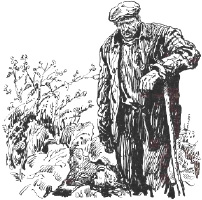
E.T. Nosov «The Doll»
The Hero of this story denounces human‘s cruelty and tries to improve the terrible and heartless things some people could do:
«Куклу бросил ребенок. Кукла быстро свалилась,
Стукнулась глухо о землю и навзничь упала…
Бедная кукла! Ты так неподвижно лежала
Скорбной фигуркой своей, так покорно сломилась,
Руки раскинула, ясные очи закрыла…
На человека ты, кукла, вполне походила!
(Кукла К.К. Случевский)
I think that these works once more show us, that puppets have «a human» soul that can be mended and ruined easily.
Grand puppet production appeared in Europe in the Middle ages, in the 14th century : Dance dolls of wood and cloth, dressed in fashionable outfits demonstrated the latest trends, they were very expensive. Pandora dolls were only for the rich. Toys had been changed a little by the 16th century: children still played with wade dolls. The first dolls houses appeared in Germany in 1558. The middle class girls played with wooden or porcelain dolls. The great English writer Katherine Mansfield wrote a short story «The Doll’s House».
The author of « The Doll’s House» is commenting on how hard it is to raise the social status. The class that person is born in is usually the class where they spend the rest of their life.
It is hard to change their future because everyone else is so focused on their parents past. The Burnells (Kezia, Isabel and Lottie) are one of the higher – ranking families.
Class distinction is also the major theme of this short story – Little Kelveys were outskirts, but they were little children who would dream of such wonder and joy as a real doll’s house: «Oh-oh!» The Burnell children sounded as though they were in despair. It was too marvelous; it was too much for them. They had never seen anything like it in their lives. All the rooms were papered. There were pictures on the walls, painted on the paper, with gold frames complete. Red carpet covered all the floors except the kitchen; red plush chairs in the drawing-room, green in the dining-room; tables, beds with real bedclothes, a cradle, a stove, a dresser with tiny plates and one big jug. But what Kezia liked more than anything, what she liked frightfully, was the lamp. It stood in the middle of the dining-room table, an exquisite little amber lamp with a white globe. It was even filled all ready for lighting, though, of course, you couldn’t light it. But there was something inside that looked like oil, and that moved when you shook it.’’
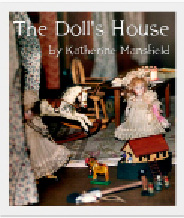
The Doll’s House. Katherine Mansfield
By this story K.Mansfield shows how toys can display social difference in any society.
A lot of new toys were invited in the 20th century, today you can watch a parade of Lego toys. Barbie dolls were invented in 1959 and Action Man went on Sale 1966. At the end of the 20th century computes games became popular.
У детства аромат совсем особый
Там пироги и вкус румяной сдобы
Там солнце, речка, дышится легко….
Там вкус вишнёвый, яблочный, сливовый
Стрекоз и бабочек весёлый рой
Ах детство, детство! Мы давно знакомы
Жаль, не вернуться нам к себе домой!
Татьяна Лаврова
The theme of childhood is also widely reflected by the great Masters of Art. The Great Russian painters paid their attention and love to children and their everyday life: toys, favorite pets, books and etc.
The theme is very favorable! The most popular Masters: V. Tropinin, K. Makovsky, V. Surikov, B. Kustodiev, A. Harlamov, A. Korzukhin give us a wide understanding of history of Russian puppets.
I’d like to analyze V.Tropinin’s «The Girl with a Doll» – 1841. The work was painted in the style of Romanism. The style helped him to give his work some shade of soul feeling and sincerity, seriousness and dreaming sadness.
V. Tropinin would not once said: «The Best Teacher is Nature, you must only give yourself to it with all your soul, love it with all your heart, and only then a man will be purer, more moral». Just such favorable «Nature» was found by the artist in children. Kind and responsive, he was the first of Russian painters, who created of a lot of children’s portraits – portraits with animals, birds and toys.
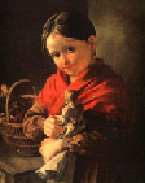
V. Tropinin «The Girl With A Doll»
His work «The Girl with a Doll» is recognized the world
best Masterpiece – it is pierced with childish love for her toy. It is the painting of kindness and quietness.
One more «children’s» artist has drawn my attention. He is the great English Master – Harry Brooker (1848–1940), Being the father of great family –six children – he knew best of all how to entertain his little ones – of course, with toys!
In style H. Brooker is a jenre – painter, his works show us everyday situations in the life of playing kids. His pictures «Tea Party For a Doll» – 1893, «The Dress For a Doll» – 1908, «Knitting and Dolls» – 1909, «Dressing Dolls», «Young Dressmakers» convince us once more childhood is a magic world of dolls, that live, develop with children, cry and laugh, sing and dance, make wonders with our little ones!
The difference between adults and the children is the cost of their toys.
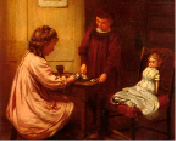
H. Brooker «Tea Party For a Doll»
Если дети много и усердно играют в куклы, – то будет прибыль и достаток.
А если дети небрежно к ним относятся, то быть беде!
Русская народная пословица
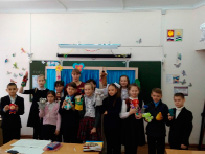
Everyone loves puppets! They are fun, sometimes crazy, and even when they are sad they still make us laugh!
Our school puppet theatre «Mitten» – the students of the 3 grade «b» did the project «Happiness Will Save The Warmth Of Hearts». The initiative of school children was a success – the school won the grant in 3090 rubles. The puppets were bought on this sum, and with the help of parents – a theatre screen. The main purpose of our puppet theatre – to give joy and high spirits to children and their parents: «The Land of Knowledge» was shown for the children of the 1–2 grades: All the fairy tale characters came to meet kids: The Red Hooding Cap, Doctor Aibolit, Pirate and others.
The actors were presented a new puppet for their future successful performances. Little actors have a lot of interesting toying shows with, a symbol of the Year – Dog ahead!
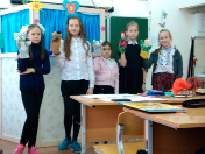
The theme of childhood and toys is not only the theme of my Research, I think that it is also very actual for my native town Kumertau. In the article of the newspaper ‘’The Kumertauskoye Vremya’’ – «Presents, toys are more pleasant to give, than to take»
I have read about people who are not different to children’s needs and troubles. Presents, toys, sweets, money and a lot of other things helped to children’s dreams come true by kind townsmen: and Father Frost – A. Komlev and his New Year Team «Ангел – Подорожник»:
«Как радовались дети – сложно описать! В каких условиях некоторые дети живут – передать трудно. По-разному реагировали детишки на появление сказочных героев: кто-то торопился переодеться в самые нарядные платьица. Подарки получили все: и бойкие, и тихие! «Спасибо, – говорили нам и ребятишки, и их родители».
«The Kumertauskoye Vremya». 29.12.18.
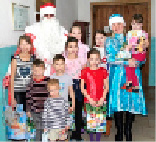
Surveying the concept «toying with dolls» among schoolchildren
We conducted a survey among 45 students, 15 teachers and 6 adults of the secondary school № 12. The purpose of the survey was to find out the main meanings of the conсept «toying with dolls» in their lives:
1. Do you like to play with toys?
2. Do you remember your first toys?
3. What rag dolls did you play in the early childhood?
4. What puppets did your parents play in their childhood?
5. Is it useful to play with the puppets?
6. What kind of toys will the kids play in the future?
7. Can you make a rag doll yourself?
8. What does playing with the puppets give you?
a) fun
b) joy
c) knowledge
d) practice work with fingers
The results of the survey showed that:
70% of schoolchildren noted the positive impact of playing with the toys, 20% negative , and 10% the theme does not matter
For 95% of adults «puppet» gives a positive mood, for 5% it does not matter
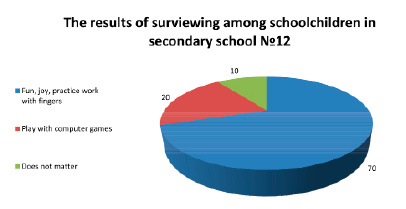
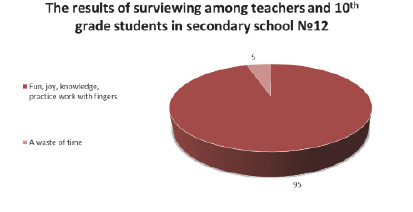
Conclusion
«Без нее, без куклы,
Мир бы рассыпался, развалился,
И дети перестали бы походить
На родителей, и народ бы
Рассеялся пылью по лицу земли».
«Голос хора» А.Синявский
We are the children of the Earth and regardless of age, race, nationality understand clearly that the protection of childhood and everything that concerns this problem should be considered a top priority in our state’s policy today. In my Research I have investigated the question of Toying with the Past – the origin of dolls and their influence upon the fate of people in some cultures. I have enjoyed greatly to have found a lot of information on this theme: It was a great traveling in the past of our history! First Slavonic dolls, the dolls around the world, I got acquainted with old customs and traditions of toying. I think that my work will be interesting and useful for those who work with children. The received results of my research can be used at class meetings and school conferences and at the lessons of Literature, History and Art. The results of my work will teach children to understand better their own culture, ethnic roots, and origin. I am sure that the children will value better family traditions, the inner world of every home and order in it. And, of course, they will learn to appreciate their old toys: first dolls, bears, cubes. And what more, I’ve learnt to make folk rag dolls myself, it’s a great pleasure, indeed!
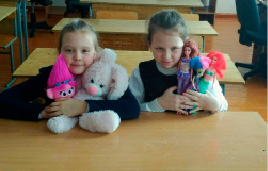
Special thanks to Butyrina Svetlana Sergeevna.
Библиографическая ссылка
Краилов Д., Мигранова К. I WOULD I WERE A CARELESS CHILD… TO BRING BACK GLIMPSES OF THE PAST! // Международный школьный научный вестник. – 2018. – № 6-2. ;URL: https://school-herald.ru/ru/article/view?id=825 (дата обращения: 16.04.2024).
